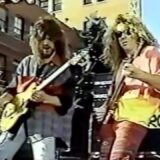Before we begin, I need you to understand something. This isn’t a story about getting high. This is a story about how a plant older than human civilization became the excuse for a war that reshaped entire societies, destroyed millions of lives, and changed the very fabric of law and order across the globe. So, if you’re here for the journey, take a moment to like this video and subscribe, but only if you genuinely want to go deep. Let me know in the comments where you’re watching from and what time it is there. The world is wide and this story touches every corner of it. Phone away, distractions silenced. Let’s begin. In the beginning, there was hemp. Not marijuana, not weed, not cannabis, just hemp. A tall, fibrous plant with serrated leaves that could grow almost anywhere humans settled. Its origins are lost in the mists of deep time, somewhere in the steps of Central Asia, perhaps in what is now Mongolia or the Tibetan plateau. Archaeological evidence suggests that humans and cannabis have been partners for at least 10,000 years, possibly longer. This was not a partnership born of intoxication. It was born of necessity. The ancient peoples of the Neolithic age, those first farmers who abandoned the nomadic life and began to shape the earth to their will, quickly discovered that this plant was a gift. Its fibers were among the strongest in nature. When stripped from the stalk, dried, and twisted into rope, hemp could bear enormous weight without breaking. It could be woven into fabric that was durable, breathable, and resistant to rot. In a world where survival meant ingenuity, where every resource had to be maximized, hemp was indispensable. It clothed bodies. It made the sails that caught the wind. It became the ropes that bound civilization together. Quite literally, by 8,000 B.CE., Hemp cultivation had spread across Asia. In ancient China, it was one of the five sacred grains, though technically it wasn’t a grain at all. The Chinese used every part of the plant. The seeds were pressed for oil, a nutritious food source. The fibers became clothing and paper. Yes, paper. The oldest known fragments of paper dating to the 2nd century B.C.E. were made from hemp. The Chinese Pharmacapia, one of the world’s first comprehensive medical texts, listed cannabis as a remedy for everything from rheumatism to malaria to absent-mindedness. The legendary emperor Shenong, the father of Chinese agriculture and medicine, allegedly prescribed it around 2737 B.C.E. for gout and other ailments. Whether this is historical fact or mythologized wisdom, it speaks to how deeply embedded cannabis was in the ancient world. It wasn’t just medicine and material. It was also quietly, subtly, a doorway to altered consciousness. The ancient Cythians, those fierce nomadic horsemen who terrorized the steps from the Black Sea to the borders of China, understood this well. The Greek historian Heroditus, writing in the fifth century B.C.E. described their ritual use of cannabis with the precision of an anthropologist. After a funeral, he wrote, “The Cyians would construct small tents, place heated stones inside, and throw hemp seeds onto the stones. The tent would fill with thick aromatic smoke, and the mourers would inhale deeply, howling with pleasure. It was a ritual of release, of transcendence, a way to touch the spirit world and honor the dead. This was not recreational use in the modern sense. It was sacrament. As trade routes expanded, as empires rose and fell and the great caravans moved along the silk road, cannabis traveled with them, it arrived in India, and there it found its spiritual home. In the Hindu tradition, cannabis became intertwined with the god Shiva, the destroyer and transformer. Legend held that Shiva himself consumed bang, a drink made from ground cannabis leaves mixed with milk, spices, and honey. It was said to bring clarity, to aid meditation, to open the doors of perception. Pang was consumed during festivals, particularly holi, the festival of colors, and it remains legal and widely used in India to this day. Cannabis in the form of bang, ganja and charas became woven into the religious and cultural fabric of the subcontinent. It was the plant of aesthetics and holy men of yogis seeking enlightenment in the high Himalayas. From India, it spread to the Middle East and Africa. In the ancient world, cannabis was everywhere, a silent partner in the great unfolding of human civilization. But in the west, in Europe, its story was different. The Greeks and Romans knew of it certainly. They used hemp for rope and textiles. But the psychoactive properties, the idea of smoking or ingesting it for its mind-altering effects, did not take root in European culture. Not yet. For them, cannabis was a crop, not a sacrament. It was useful, not mystical. For millennia, this was the equilibrium. Cannabis existed in dozens of forms across dozens of cultures, each using it according to their needs and beliefs. It was medicine in China, rope in Rome, a sacred intoxicant in India, a morning ritual among the Cytheians. It was ubiquitous and unremarkable, part of the landscape of human agriculture. No one feared it, no one demonized it. It was simply a plant, and like all plants, it served. Then the world changed. The age of exploration dawned, and with it came the age of hemp‘s greatest utility, and paradoxically, the seeds of its future persecution. The tall ships that carried European empires across the oceans to claim new worlds were built on hemp. Every rope, every sail, every bit of rigging and caulking on those vessels was made from it. A single large warship required over 50 tons of hemp for its construction. Without hemp, there would have been no age of sale, no global empires, no Colombian exchange. Hemp was strategic. It was a naval necessity as vital to national security as steel or gunpowder. When European colonizers arrived in the New World, one of the first things they did was plant hemp. In6006, French botonist Louis Haber planted the first hemp crop in North America in what is now Nova Scotia. The English followed suit in Virginia in 1611. Colonial authorities didn’t just encourage hemp cultivation, they mandated it. In Virginia, by law, every farmer was required to grow hemp. Failing to do so could result in fines or imprisonment. George Washington grew hemp at Mount Vernon. Thomas Jefferson grew it at Montichello. Benjamin Franklin owned a paper mill that processed hemp. The first drafts of the Declaration of Independence were written on hemp paper. This was not a counterculture crop. This was the crop of the establishment, the backbone of the colonial economy. Hemp was money. It was so valuable that in some colonies it could be used to pay taxes. It was woven into the very fabric of the emerging American republic quite literally. The canvas of covered wagons that pushed westward across the frontier. Hemp, the ropes that built the railroads. Hemp. Levy Strauss made the first denim jeans from hemp fiber, durable enough to withstand the rigors of gold prospectors. But here’s where the story splits. Where the single plant begins to lead a double life. The hemp grown for industrial purposes, fiber, seed, paper, was a variety of cannabis sativa bred over generations to maximize stalk strength and minimize psychoactive compounds. The plants were tall, fibrous, and contained very little tetrahydrokinabonol or THC, the chemical responsible for the marijuana high. It was industrial hemp and smoking it would give you nothing but a headache. But there were other varieties in the warm climates of India, Mexico, the Caribbean and parts of Africa. Cannabis indica and certain sativa strains had been cultivated for their flowers. They’re resinrich buds that contained far higher concentrations of THC. These were not rope plants. These were drug plants. And as global trade and migration accelerated in the 19th and early 20th centuries, these two worlds, industrial hemp and psychoactive cannabis, began to collide in the Western consciousness. The collision happened slowly at first. In the 1830s and 40s, European colonial doctors stationed in India began writing about the medical properties of cannabis. An Irish physician named William Brook Shaesy conducted extensive research in Kolkata and published his findings in 1839. He reported that cannabis tinctures were remarkably effective for treating muscle spasms, rheumatism and convulsions. He brought samples back to England and soon cannabis extracts were being prescribed across Europe and America. By the 1850s, cannabis was listed in the United States Pharmacapa, the official compendium of recognized medicines. You could walk into any pharmacy and purchase cannabis tinctures, extracts, and pills. They were marketed for everything from migraines to menstrual cramps to insomnia. The pharmaceutical companies of the era, Park Davis, Eli Liy, Squib, all produced cannabis-based medications. There was no stigma, no moral panic. It was simply medicine, one of dozens of herbal remedies available to the public. But medicine was not the only way cannabis was entering Western society. In the 1840s, a group of French romantic writers and artists formed a club in Paris called Llub Deashish, the club of the Hashittas. Members included literary giants like Charlair, Alexandra Dumar, and Victor Hugo. They would gather in a hotel on the il sanlui, consume a thick green paste of cannabis mixed with honey, and then spend the evening exploring the altered states of consciousness it produced. Bodilair wrote extensively about his experiences, describing the drug’s ability to distort time, amplify sensations, and unlock creative visions. He also warned of its dangers, the way it could seduce the user into a passive dreamlike state that sapped the will. This was cannabis as an exotic intellectual curiosity. It was bohemian, transgressive, tinged with orientalism. The West was fascinated by it, but it remained firmly on the margins, a play thing of artists and adventurers. The general public had no interest in smoking hashish. They had their medicine in tincture form, and that was sufficient. Then came the great migration and with it the demonization. In the late 19th and early 20th centuries, waves of immigrants flooded into the United States. From Mexico came workers fleeing the chaos and violence of the Mexican Revolution, which began in 1910. They brought with them their language, their culture, and their customs. Among those customs was the smoking of marijuana. Marijuana in Spanish, a practice common among the lower classes in Mexico, particularly soldiers and laborers. It was used recreationally and medically. A cheap and accessible way to relax after a long day of backbreaking work. The Mexican immigrants settled primarily in the Southwest, Texas, New Mexico, Arizona, California, taking jobs in agriculture, railroads, and mining. And almost immediately, the marijuana they brought with them became a flash point for racial and economic anxieties. This is where the story turns dark, where the plant becomes a weapon in a larger cultural war. The word itself is significant. Americans had been using cannabis for decades in a medical context. But marijuana was a foreign word, a Mexican word. And by deliberately using this term, anti-cannabis crusaders, could make the drug seem alien, dangerous, associated with an immigrant population that much of white America viewed with suspicion and hostility. Local newspapers, particularly in Texas, began running sensationalized stories about marijuana crazed Mexicans committing crimes. The drug was blamed for violence, insanity, and moral decay. It was a convenient scapegoat, a way to channel broader anti-immigrant sentiment into a specific legislative target. In 1914, El Paso became one of the first US cities to ban the sale and possession of marijuana. The motivation was transparent. The city council wanted to control the growing Mexican population, and criminalizing their drug of choice gave the police a tool to do so. This pattern repeated across the Southwest. By the 1920s, over a dozen states had passed anti-marijuana laws, almost all of them in states with significant Mexican immigrant populations. The drug war had begun, but at this stage, it was still local, fragmented, and explicitly tied to xenophobia. Meanwhile, in the urban centers of the north, another cultural shift was occurring. African-Americans migrating from the rural south as part of the great migration brought with them the culture of jazz. And in the smoky underground clubs of New Orleans, Chicago, Kansas City, and Harlem, jazz musicians discovered that marijuana enhanced their music. It slowed time, heightened sensory perception, allowed improvisational flights that felt transcendent. Louisie Armstrong was a lifelong user, referring to it as gauge, and crediting it with relaxing him and making his music flow. Cab Callaway sang about Reefer in his 1932 song Reefer Man, a playful coded ode to the drug. But what was celebrated within the black jazz community was viewed with alarm by white America. Jazz itself was seen as dangerous, as primitive, as sexually provocative. And marijuana became associated with this threat. It was black music, black culture, black deviants. The drug was no longer just a Mexican problem. It was a negro problem, too. This racial dimension cannot be overstated. The campaign against marijuana was never primarily about public health or pharmarmacology. It was about control. It was about targeting communities that the establishment viewed as dangerous, undesirable, or politically inconvenient. The drug was the excuse. The goal was suppression. And into this volatile mix stepped a man who would become the face of American drug prohibition for nearly four decades. His name was Harry Anslinger. Harry Jacob Anslinger was appointed the first commissioner of the Federal Bureau of Narcotics in 1930, a position he would hold until 1962. He was a bureaucrat, a moralist, and a master of propaganda. And he dedicated his career to one mission, the eradication of marijuana. In the early years of his tenure, Anslinger actually paid little attention to cannabis. His focus was on opiates and cocaine, the drugs that had been federally regulated since the Harrison Act of 1914. But as the Great Depression deepened and the bureau’s budget came under threat, Anslinger needed a new crusade to justify his agency’s existence. Marijuana, which was still largely unregulated at the federal level, presented the perfect opportunity. Hansslinger launched a media campaign that was as relentless as it was dishonest. He cultivated relationships with newspaper editors and fed them a steady stream of lurid stories designed to terrify the public. His propaganda borrowed heavily from the racist narratives already circulating in the Southwest and the urban north. Marijuana, he claimed, made users violent, insane, and sexually deviant. He testified before Congress with chilling anecdotes, tales of marijuana adult men committing ax murders and raping white women. One of his most frequently cited cases was the story of Victor Licarta, a young man in Florida who killed his family with an ax in 1933. Anslinger claimed marijuana was the cause, despite the fact that Licarta had a documented history of severe mental illness, and there was no evidence he had used the drug. The truth didn’t matter. The story served its purpose. Anslinger’s rhetoric was explicitly viciously racist. In private correspondence and public testimony, he spoke of reefer crazed negroes and warned that marijuana caused white women to seek sexual relations with black men and entertainers. He collected and circulated a file of gore files, sensationalized reports of marijuana related crimes, most of them unverified or completely fabricated. He understood that fear, particularly racial fear, was the most effective tool for shaping public opinion. Hollywood, eager to capitalize on the hysteria, produced exploitation films that reinforced Anslinger’s narrative. The most infamous was Reefer Madness, released in 1936. Originally titled Tell Your Children, the film depicted marijuana as a one-way ticket to insanity, violence, and death. Clean-cut teenagers are lured to a marijuana party and within minutes they’re hallucinating, playing piano maniacally, laughing hysterically, committing vehicular manslaughter, and descending into suicide and madness. It was absurd over-the-top propaganda, but it was widely distributed to schools and churches as an educational film. The campaign worked. By 1937, Anslinger had built enough political momentum to push for federal legislation. The result was the Marijuana Tax Act of 1937. Technically, the law did not criminalize marijuana outright. Instead, it imposed a prohibitively expensive tax on anyone who cultivated, prescribed, or sold cannabis. It required registration, special order forms, and the payment of fees that made compliance virtually impossible for the average person. It was prohibition by bureaucracy. During the congressional hearings, the American Medical Association sent a representative, Dr. William Woodward, to testify against the bill. He pointed out that cannabis had legitimate medical uses, that there was no scientific evidence it caused the violence and insanity, Anslinger claimed, and that the term marijuana was deliberately being used to obscure the fact that they were talking about a medicine doctors had been prescribing for decades. His testimony was ignored. The industrial hemp farmers also objected. They argued that hemp cultivation was vital for rope, textiles, and paper production. But by this point, synthetic fibers like nylon were being developed by companies like DuPont, and wood pulp had become the primary source for paper. Some historians have argued, though this remains debated, that corporate interests in these industries quietly supported the prohibition of hemp to eliminate a competitor. Whether conspiracy or confluence, the result was the same. Hemp, despite its industrial importance, was swept up in the prohibition of marijuana. The Marijuana Tax Act passed with little opposition. Few members of Congress understood what they were voting on, and fewer still cared. It was presented as a law to control a dangerous drug used by Mexicans and black people. That was enough. And so almost overnight, a plant that had been cultivated for 10,000 years, that had clothed armies and fed populations and healed the sick, became contraband. The war had been declared. The enemy had been named. And for the next 80 years, that war would escalate, metastasize, and consume entire societies. But the plant, stubborn and resilient, refused to disappear. World War II forced a temporary, awkward truce in the war on marijuana. When Japan invaded the Philippines and cut off America’s supply of Manila hemp, a different plant despite the name, the US military faced a crisis. Hemp was essential for rope, rigging, and parachute webbing. Without it, the war effort was in jeopardy. The government, with remarkable cognitive dissonance, reversed course. The USDA launched the Hemp for Victory campaign in 1942, producing a propaganda film that urged American farmers to plant hemp as their patriotic duty. Farmers who grew hemp were exempt from military service. Over 400,000 acres were planted across the Midwest. The plant that had been demonized just 5 years earlier was suddenly a hero. But the moment the war ended, so did the tolerance. The hemp fields were plowed under, the program was forgotten. So thoroughly forgotten that for decades the government denied the hemp for victory film had ever existed until copies were unearthed in the Library of Congress and the National Archives. The war on marijuana resumed as if it had never been interrupted. In the postwar years, marijuana use remained relatively rare in mainstream America. It was still associated with jazz musicians, Mexican laborers, and the fringes of Bohemian culture. The Beats of the 1950s, Jack Herowak, Alan Ginsburg, William S. Burroughs embraced it as part of their rejection of conformist society, but they were outliers, cultural rebels whose influence was limited. Then came the 1960s and everything changed. The counterculture explosion of the 1960s was many things. A youth rebellion, a sexual revolution, a rejection of authority, but it was also undeniably a drug culture. And marijuana was its sacrament. It spread from the jazz clubs and beat poetry readings into college campuses into suburban bedrooms into the vast sprawling consciousness of a generation that was questioning everything their parents had told them. Marijuana became a symbol. To smoke it was to declare yourself opposed to the Vietnam War, opposed to racism, opposed to the stifling conformity of 1950s America. It was a political act wrapped in rolling papers. The hippies in San Francisco’s hate Ashbury, the protesters at Kent State, the crowds at Woodstock, they were united by music, by idealism, and by marijuana. The establishment was horrified. Once again, marijuana was associated with a group that threatened the social order. Not Mexicans or black jazz musicians this time, but white middle-class kids, the sons and daughters of respectable families, dropping out, tuning in, and lighting up. Parents were terrified. Politicians smelled opportunity. Richard Nixon, running for president in 1968, made law and order the centerpiece of his campaign. To him and his advisers, the counterculture was not just a cultural movement. It was a political enemy. In a now infamous quote from John Erlicman, Nixon’s domestic policy adviser, revealed in a 1994 interview, the Nixon campaign in 1968 and the Nixon White House after that had two enemies, the anti-war left and black people. We knew we couldn’t make it illegal to be either against the war or black. But by getting the public to associate the hippies with marijuana and blacks with heroin, and then criminalizing both heavily, we could disrupt those communities. We could arrest their leaders, raid their homes, break up their meetings, and vilify them night after night on the evening news. Did we know we were lying about the drugs? Of course we did. This is not conspiracy theory. This is documented strategy. The war on drugs, as articulated by Nixon and executed by every administration since, was never primarily about drugs. It was about control, about suppressing disscent, about targeting communities that challenge the political status quo. In 1970, Nixon signed the Controlled Substances Act, which created five schedules for classifying drugs based on their medical value and potential for abuse. Marijuana was placed in schedule one, the most restrictive category defined as having no currently accepted medical use and a high potential for abuse. It was classified alongside heroin and LSD and above cocaine and methamphetamine which were placed in schedule 2. This classification was not based on science. A commission Nixon himself appointed, the Schaefer Commission, spent 2 years studying marijuana and concluded in 1972 that it should be decriminalized. Nixon ignored the report and buried it. The Machinery of Enforcement expanded rapidly. The Drug Enforcement Administration was created in 1973, consolidating federal drug enforcement powers. State and local police departments received federal funding and military equipment to fight the drug war. Mandatory minimum sentences were introduced, stripping judges of discretion and ensuring that even minor marijuana offenses could result in years in prison. And the arrests began by the millions. The numbers are staggering. Between 1965 and 2020, over 26 million Americans were arrested for marijuana offenses. 26 million, that’s more than the entire population of Australia. The vast majority, approximately 88%, were arrested for simple possession, not dealing or trafficking. They were users, often young, often caught with small amounts for personal use. The racial disparities in these arrests are equally staggering. Despite similar usage rates across racial groups, studies consistently show that white people and black people use marijuana at roughly the same rates. Black Americans are nearly four times more likely to be arrested for marijuana possession. In some states, the disparity is even higher. In Montana, black people are nearly 10 times more likely to be arrested for marijuana than white people, despite making up less than 1% of the state’s population. This is not accidental. This is policy. The war on drugs gave law enforcement the tools and the justification for aggressive policing of minority communities. Stop and frisk policies, broken windows policing, no knock raids, all were justified in the name of drug enforcement. Marijuana was the lowhanging fruit, the easiest charge to bring, the simplest way to feed the growing prison industrial complex. Because that’s what was being built, an industry. Private prisons emerged in the 1980s. Corporations that contracted with states to house inmates for profit. Their business model depended on high incarceration rates. Marijuana arrests provided a steady stream of inventory. The consequences for those arrested were catastrophic and lifelong. A marijuana conviction, even for a small amount, could mean jail time. But the punishment didn’t end there. It meant a permanent criminal record that would show up on every job application, every housing application, every background check. It meant ineligibility for federal student loans, for public housing, for food stamps. It meant the loss of professional licenses, the loss of the right to vote in many states, the loss of parental rights and custody battles. A single joint could derail an entire life. Families were destroyed. Communities were hollowed out. In the height of the crack epidemic in the 1980s and ’90s, when mass incarceration reached its peak, entire generations of black and Latino men were funneled through the criminal justice system. The social fabric of neighborhoods was torn apart. Children grew up without fathers. The stigma of incarceration created cycles of poverty and crime that persisted for decades. And all the while, marijuana use continued to rise because that’s the fundamental failure of prohibition. It doesn’t work. It never has. Alcohol prohibition in the 1920s didn’t stop people from drinking. It just created a massive black market, enriched organized crime, and led to the deaths of thousands from tainted bootleg liquor. Marijuana prohibition followed the exact same pattern. By the 1970s and 80s, marijuana cultivation was big business in the United States. Domestic growers, particularly in California’s Emerald Triangle, Humbult, Mendescino, and Trinity counties, were producing highquality cannabis that could compete with imports from Mexico and Colombia. The remote, heavily forested mountains provided perfect cover, growers planted small, hidden plots deep in the national forests, far from roads and prying eyes. The government responded with force. In California, they launched the campaign against marijuana planting or camp in 1983. Helicopter raids became routine. Heavily armed officers would descend on rural properties, often without warrants, seizing plants, and arresting growers. The raids were paramilitary operations, complete with automatic weapons, body armor, and night vision equipment. But they couldn’t stop it. For every plot they found and destroyed, 10 more were planted the next season. The economics were too compelling. A single mature cannabis plant could be worth $1,000 to $3,000 on the black market. For struggling rural communities, for people who had lost their jobs when the timber industry collapsed, marijuana cultivation was a lifeline. The irony is bitter. Prohibition, which was sold as a way to eliminate marijuana, instead created the perfect conditions for its proliferation. Without legal regulation, there was no quality control, no age restrictions, no taxation. The entire market was handed to criminals, and those criminals got very, very rich. In Mexico, marijuana had been a relatively minor crop compared to opium poppies and cocaine transit. But in the 1980s, as the Colombian cartels focused on cocaine and the US government pressured Mexico to eradicate poppy fields, marijuana cultivation exploded. The cartels, Sinaloa, Gulf, Wuarez, planted vast fields of cannabis in the mountains of the Sierra Madre. These weren’t small plots hidden in the forest. These were industrial operations. Thousands of plants stretching across hillsides, irrigated and tended by campinos who worked at gunpoint. The cartels had learned from the cocaine trade. Vertical integration was the key to profit. They controlled everything from cultivation to smuggling to distribution in US cities. The violence that had defined the cocaine wars spread to the marijuana trade. Rival cartels fought for control of smuggling corridors. Farmers who refused to grow marijuana or who tried to sell to competitors were murdered. Local police and officials were corrupted or killed. By the 2000s, entire regions of Mexico were effectively lawless, controlled by narco armies that outgun the government. The human cost was catastrophic. Between 2006 and 2020, over 300,000 people were killed in Mexico’s drug war. Tens of thousands more disappeared, their bodies buried in mass graves or dissolved in acid. Journalists who reported on the cartels were assassinated. Politicians who opposed them were gunned down in broad daylight. The violence spilled across the border with cartels establishing distribution networks in every major US city. And a significant portion of this violence, this death, this suffering was over a plant that half of US states would eventually legalize. Because while the drug war raged, something remarkable was happening at the grassroots level. People were pushing back. The counterculture had never really gone away. It had just gone underground. Through the 1970s, 80s, and ’90s, activists and advocates worked to change the narrative around marijuana. Organizations like Normal, the National Organization for the Reform of Marijuana Laws, lobbyed for decriminalization. High Times Magazine, founded in 1974, celebrated cannabis culture and provided a platform for legalization arguments. Scientists, too, were pushing back against the propaganda. Research into the endockinabonoid system, the network of receptors in the human body that interact with cannabis compounds, revealed that marijuana was far less harmful than alcohol or tobacco. Studies showed it was not a gateway drug, that it did not cause violent behavior, that it had legitimate medical applications for conditions ranging from chronic pain to epilepsy to the side effects of chemotherapy. But the breakthrough came not from scientists or activists. It came from patients. In the 1980s, as the AIDS epidemic ravaged the gay community, particularly in San Francisco, patients discovered that marijuana helped. It stimulated appetite in people wasting away from the disease. It reduced the nausea caused by the brutal early HIV medications. It provided relief from the chronic pain of neuropathy. For many, it was the difference between being able to eat, to function, to have some quality of life, and simply suffering until death. The activist Dennis Peron himself, HIV positive, opened the San Francisco Cannabis Buyers Club in 1992. It was the first public dispensary in the United States, operating openly despite its illegal status. Peron and his partner provided marijuana to AIDS patients, and the local authorities, seeing the humanitarian dimension, largely left them alone. This was the seed of the medical marijuana movement. Prawn drafted Proposition 215, the Compassionate Use Act, and got it on the California ballot in 1996. The measure would allow patients with a doctor’s recommendation to legally use marijuana for medical purposes. It was a direct challenge to federal prohibition. The establishment fought back hard. The DEA threatened to arrest doctors who recommended marijuana. The Clinton administration warned that federal law superseded state law. Opponents ran ads claiming that Prop 215 was just a backdoor to legalization, that it would lead to marijuana stores on every corner. They were right about that last part. And on election night in November 1996, Prop 215 passed with 56% of the vote. California became the first state to legalize medical marijuana the dam had cracked. Within a few years, other states followed Oregon, Washington, Alaska, Maine. By 2010, 15 states had medical marijuana laws. By 2020, that number had risen to 36 states, plus Washington, DC. The medical marijuana industry, even operating in a legal gray zone, legal under state law, but illegal under federal law, was generating billions of dollars in revenue. But medical marijuana, for all its therapeutic value, was also clearly a stepping stone. The dispensary system in California quickly became a thinly veiled way for recreational users to access marijuana. Getting a medical recommendation was trivially easy. Walk-in clinics would hand them out after 5-minute consultations. The real battle, the endgame, was full legalization. That battle would be fought in Colorado and Washington in 2012. The legalization campaigns in those two states were carefully orchestrated, wellunded, and strategically brilliant. The activists had learned from decades of failure. They knew they couldn’t win on libertarian arguments about personal freedom or counterculture appeals to rebellion. They had to make the pragmatic case. The message was simple and powerful. Prohibition has failed. It has cost billions of dollars, destroyed millions of lives, and hasn’t stopped anyone from using marijuana. Legalization means regulation, taxation, and control. It means taking the market away from cartels and gangs and putting it in the hands of licensed, regulated businesses. It means ending the arrest and incarceration of non-violent users. It means treating marijuana like alcohol, legal for adults, regulated for safety, taxed for public benefit. On November 6th, 2012, voters in Colorado and Washington approved ballot measures to legalize recreational marijuana for adults 21 and over. It was a historic moment, the first time any jurisdiction in the world had fully legalized cannabis through a Democratic vote. The federal government’s response was uncertain. Technically, marijuana was still illegal under federal law, schedule 1, no accepted medical use. The DEA could have cracked down, raided dispensaries, arrested growers and sellers. But the Obama administration, reading the political winds, chose a different path. In 2013, the Justice Department issued the Cole Memorandum, which essentially said that the federal government would not interfere with state legalization efforts as long as states maintained strict regulatory controls and prevented marijuana from crossing state lines or getting into the hands of miners. The floodgates opened. Alaska and Oregon legalized in 2014. California, Nevada, Maine, and Massachusetts in 2016. Canada legalized nationwide in 2018, becoming the first major industrialized nation to do so. By 2025, over half of US states had legalized recreational marijuana and 2/3 had legalized medical use. The legal marijuana industry exploded into a multi-billion dollar sector. Dispensaries, cultivation facilities, processing labs, edible manufacturers, vape companies, testing laboratories, security firms, software companies, packaging companies, an entire ecosystem of businesses emerged. By 2020, legal marijuana sales in the United States exceeded $17 billion. By 2023, that number had surged past $30 billion. Wall Street took notice. Publicly traded cannabis companies appeared on major stock exchanges. Venture capital poured in. Celebrities launched their own brands. Snoop Dogg, Willie Nelson, Mike Tyson, Whoopy Goldberg all became marijuana entrepreneurs. The plant that had been demonized for a century was now being embraced by capitalism. But legalization, for all its promise, has brought its own complications, contradictions, and failures. The first problem is the federal limbo. Marijuana remains illegal under federal law, classified as schedule Y with no accepted medical use despite overwhelming scientific evidence to the contrary and the existence of legal markets in over half the country. This creates a surreal legal landscape. Marijuana businesses, even in states where they’re fully legal, cannot use the federal banking system. Banks, fearing federal prosecution or the loss of their FDIC insurance, refuse to work with cannabis companies. As a result, the industry operates largely in cash. Dispensaries take in thousands, sometimes millions of dollars in cash every month. They have to pay their taxes in cash, their employees in cash, their suppliers in cash. This makes them targets for robbery and creates massive logistical and accounting challenges. The IRS, meanwhile, punishes cannabis businesses with section 280E of the tax code, which prohibits businesses trafficking and controlled substances from deducting normal business expenses. A regular business can deduct rent, salaries, utilities, and operating costs. A cannabis business cannot. They can only deduct the cost of goods sold. This means effective tax rates of 70% or higher, a crushing burden that makes profitability nearly impossible for many operators. The contradiction is absurd. States are collecting billions in marijuana tax revenue. Colorado alone has collected over $2 billion since legalization, while the federal government simultaneously punishes these same businesses with confiscatory taxation and denial of banking services. The second problem is equity, or rather the lack of it. The people who are getting rich from legal marijuana are overwhelmingly white. The people who went to prison for marijuana are overwhelmingly black and brown. The irony is as bitter as it is predictable. The drug war destroyed minority communities and now those same communities are largely shut out of the legal industry that’s been built on the backs of their suffering. The barriers to entry in the legal cannabis market are enormous. Licenses are limited and expensive, often costing hundreds of thousands of dollars just to apply with no guarantee of approval. The regulatory compliance costs are staggering. security systems, testing requirements, packaging and labeling standards, inventory tracking software. Starting a legal cannabis business requires millions of dollars in capital. And where do you get that capital? Not from banks, which won’t touch the industry. Not from traditional investors, many of whom are still wary of federal illegality. You need private wealth, connections, or access to venture capital. Things that communities decimated by the drug war generally don’t have. Some states have tried to address this with social equity programs, offering priority licensing or reduced fees to applicants from communities disproportionately impacted by marijuana prohibition. But these programs have been plagued by problems, insufficient funding, bureaucratic delays, lack of access to capital, even with a license, and in some cases, outright fraud, with wealthy applicants using minority partners as fronts to gain social equity status before buying them out. Meanwhile, the criminal justice system continues to operate as if nothing has changed. In states where marijuana is legal, thousands of people remain in prison for offenses that are no longer crimes. Some states have implemented automatic expungement of marijuana convictions. But the process is often slow, incomplete, or requires individuals to navigate a complex legal system to clear their records. Many people convicted years or decades ago have no idea they’re even eligible for relief. And in the states that haven’t legalized, primarily in the South and the Interior West, the arrests continue. In 2020, even as the pandemic raged, over 350,000 Americans were arrested for marijuana offenses. That’s one arrest every 90 seconds. The majority were for simple possession. The drug war for millions of Americans is not history. It’s happening right now. The third problem is public health, particularly among the young. The legalization advocates promised that regulation would keep marijuana away from minors more effectively than prohibition did. The evidence on this is mixed. Some studies show no increase in youth use after legalization. Others show modest increases. What’s clear is that the potency of modern marijuana has skyrocketed. In the 1970s, the average THC content of marijuana was around 2 3%. Today, it’s common to find flour with 25 30% THC and concentrates, oils, waxes, shatters can reach 90% THC or higher. This is not your grandparents weed. This is a fundamentally different product and the health implications are still being studied. There is growing evidence of a link between high potency marijuana use and mental health issues, particularly among adolesccents and young adults. Regular use of high THC products has been associated with increased rates of psychosis, schizophrenia in vulnerable populations, and cannabis hyperemmesis syndrome, a condition characterized by severe cyclical vomiting. Heavy users can develop dependence, not the physical withdrawal of opioid addiction, but a psychological dependency that disrupts daily functioning. The industry’s marketing doesn’t help. Walk into a modern dispensary and you’ll find products that look like candy, cookies, gummy bears, chocolate bars, all infused with high doses of THC. The packaging is often deliberately designed to appeal to younger consumers. Edibles are particularly problematic because the effects are delayed and unpredictable. Someone inexperienced might eat a whole cookie, feel nothing for an hour, eat another, and then find themselves overwhelmingly terrifyingly high for 8 hours. Emergency room visits for marijuana related issues have increased in legalization states, particularly for edible overconumption and for children who accidentally ingest THC products that look like regular candy. These are solvable problems. Better packaging, clearer dosing guidelines, more public education. But they’re problems the industry has been slow to address because the priority is profit, not public health. The fourth problem is consolidation and corporatization. The dream of legalization for many advocates was a cottage industry of small growers and artisan producers, a craft cannabis culture that rewarded quality and expertise. The reality is increasingly a corporate oligopoly. Large multi-state operators, companies like Curleaf, Truliev, Green Thumb Industries are buying up licenses, building massive cultivation facilities, and pushing out smaller operators who can’t compete on price or scale. Vertical integration where a single company controls cultivation, processing and retail is becoming the norm. These corporations are racing to establish dominance before federal legalization happens, positioning themselves to become the anoer Bush or Philip Morris of cannabis. When federal legalization comes, and most analysts believe it’s a matter of when, not if, it will likely favor these large operators. They have the capital, the legal teams, the lobbyists, and the political connections to shape the regulations in their favor. The small growers in Hanold County who risked everything for decades to keep cannabis culture alive will be crushed by industrial agriculture. The craft cannabis movement will become a boutique niche if it survives at all. This is the uncomfortable truth about legalization. It’s not a victory for counterculture or for justice. It’s the commodification and corporatization of something that was once a form of rebellion. The plant is being tamed, domesticated, stripped of its revolutionary associations, and turned into just another consumer product bought and sold like beer or cigarettes. And yet, for all these problems, legalization is still preferable to prohibition. Because prohibition was never just a failure. It was an atrocity. Let’s be clear about what the war on marijuana actually accomplished. It did not reduce use. It did not protect public health. It did not make communities safer. What it did was destroy lives on an industrial scale. It filled prisons to bursting. The United States with 4% of the world’s population has 20% of the world’s prisoners. We incarcerate more people than any nation in history in absolute numbers and per capita. And a huge driver of that mass incarceration has been drug offenses. With marijuana leading the way, it cost taxpayers trillions of dollars. The direct costs of marijuana enforcement, arrests, prosecutions, incarceration are estimated at over $3.6 billion per year. But that doesn’t include the indirect costs. the lost productivity of people in prison, the lost tax revenue, the cost of foster care for children whose parents were incarcerated, the long-term economic impact on communities. The true cost is incalculable. It enriched criminal organizations. By keeping marijuana illegal, prohibition guaranteed that all profits would flow to the black market. The Mexican cartels, who made billions from marijuana before states began legalizing, were able to use those profits to fund their cocaine and heroin operations to buy weapons to corrupt officials. Prohibition was the cartel’s best friend. It distorted law enforcement. Police departments, incentivized by federal grants and asset forfeite laws, which allowed them to seize and keep property connected to drug offenses, focused on easy marijuana arrests rather than serious crime. It created perverse incentives where a cop could boost his arrest numbers and his department’s budget by stopping young black men on the street rather than investigating burglaries or assaults. It violated basic human rights. The drug war has been used to justify no knock raids that have killed innocent people. It’s been used to justify the militarization of police. It’s been used to justify searches and seizures that violate the Fourth Amendment. It’s given the state enormous power to intrude into private life, to kick down doors, to separate families, all in the name of stopping people from possessing a plant. And perhaps most damningly, it was based on lies. The claim that marijuana causes violence, a lie. The claim that it’s a gateway drug, a lie not supported by causation, the claim that it has no medical value, a lie. The claim that prohibition was about public health, the biggest lie of all. Harry Anslinger knew he was lying. Richard Nixon knew he was lying. Every administration since has known they were lying. The drug war was never about drugs. It was about power, about control, about suppressing disscent and targeting minority communities. And it worked in that sense. It achieved its real goals. It disrupted the anti-war movement. It devastated black and Latino communities. It created a permanent underclass of people with criminal records who could be disenfranchised, denied employment, denied housing, denied opportunity. It maintained the social hierarchy that those in power wanted to maintain. But the lies couldn’t hold forever. Too many people used marijuana and realized it wasn’t the demon drug they’d been told about. Too many people saw their friends, their children, their neighbors arrested for something that seemed harmless. Too many people recognized the hypocrisy of marijuana being illegal. While alcohol and tobacco, which kill hundreds of thousands of people every year, were not only legal but celebrated. The truth slowly, painfully began to win. Today, the landscape is fractured, contradictory, and rapidly evolving. In parts of the United States, you can walk into a gleaming dispensary, browse hundreds of products, consult with a bud tender about different strains and their effects, and legally purchase marijuana with a credit card. In other parts, people are still being arrested, prosecuted, and imprisoned for possessing the exact same plant. Internationally, the movement toward legalization is accelerating. Uruguay legalized in 2013, Canada in 2018. Mexico Supreme Court ruled prohibition unconstitutional, though the legislature has been slow to implement a regulatory framework. Germany is moving toward legalization. Thailand decriminalized in 2022. Even conservative jurisdictions are reconsidering their approach as they watch billions in tax revenue flowing to early adopters. The United Nations, which for decades supported global prohibition through treaties like the 1961 Single Convention on Narcotic Drugs, is beginning to soften its stance. In 2020, the UN Commission on Narcotic Drugs voted to remove cannabis from the most restrictive category of its drug schedule, acknowledging its medical value. The momentum is clear. Within a generation, marijuana prohibition will likely be remembered the way we remember alcohol prohibition as a disastrous policy failure driven by moral panic and bad science. A dark chapter in the history of social control. But the legacy of prohibition will linger for generations. The millions of people with criminal records. The communities that were devastated by mass incarceration. The trust between law enforcement and minority communities that was shattered. The lives that were derailed. the families that were broken, the potential that was wasted. That damage cannot be undone by legalization alone. True justice would require not just legalization, but reparations. It would require expuning every marijuana conviction and releasing every person still imprisoned for marijuana offenses. It would require compensating people for the years they lost to incarceration. It would require investing in the communities that were targeted by prohibition, rebuilding what was destroyed. It would require dismantling the structures of the drug war, the militarized police, the asset forfeite laws, the mandatory minimums. Some of this is happening slowly, incompletely, but much of it isn’t. The marijuana industry is being built on the ruins of the drug war, and the people who profit from legalization are generally not the people who suffered from prohibition. That injustice sits at the heart of the legalization movement. An unresolved moral debt that grows with every dispensary that opens, every stock that rises, every white entrepreneur who becomes a millionaire selling the same plant that sent black men to prison for decades. So what is marijuana really? When we strip away the century of propaganda, the decades of prohibition, the current haze of commercial marketing, it’s a plant, a remarkably versatile one with a relationship to humanity that stretches back to our earliest agricultural civilizations. It has fed us, clothed us, healed us, altered our consciousness, and inspired our creativity. It has been sacred and profane, medicine and poison, rope and rebellion. It is not harmless. No psychoactive substance is it can be abused. It can contribute to mental health problems in vulnerable individuals. It can impair judgment and coordination. It should not be used by adolescents whose developing brains are particularly susceptible to its effects. It should be regulated, controlled, and its use should be informed by honest science, not marketing hype. But it is also not the demon it was made out to be. It does not cause violence. It does not lead inexorably to harder drugs. For many people, it provides relief from pain, anxiety, insomnia, and the side effects of serious illnesses. For others, it’s a mild intoxicant, a way to relax and unwind, no more dangerous than a glass of wine. The question of marijuana has never really been about the plant itself. It’s been about who uses it, who controls it, and who profits from it. The same plant that was celebrated when it was making rope for the Navy was demonized when Mexicans smoked it. The same plant that was in every pharmacy in 1900 was criminalized when black jazz musicians embraced it. The same plant that sent people to prison for decades is now making investors rich. This isn’t about pharmarmacology. It’s about power. The story of marijuana is ultimately a story about how societies decide what is acceptable and what is forbidden and how those decisions are shaped not by evidence or reason, but by fear, prejudice, and political convenience. It’s a story about how prohibition can be weaponized to target disfavored groups. It’s a story about how moral panics can override science and common sense. And it’s a story about how eventually, if enough people resist, if enough voices speak truth, even the most entrenched injustices can begin to crumble. But the work is not done, not even close. There are still people in prison. There are still arrests happening every day. There are still communities bearing the scars of prohibition. There are still lies being told by some who oppose legalization and by some who profit from it. The truth about marijuana, the complex, nuanced, evidence-based truth, is still struggling to be heard over the noise of propaganda and marketing. The plant that was demonized is being sanitized, turned into a consumer product stripped of its history and its politics. The corporations moving into the cannabis space want customers, not activists. They want to sell you a lifestyle, not remind you of the millions who suffered under prohibition. They want you to think of marijuana as just another commodity like craft beer or artisal chocolate, something to be consumed without thought. But we cannot forget. We cannot let the normalization of marijuana erase the memory of what prohibition cost, who it targeted, and why it was really implemented. We cannot let the propheteers of legalization ignore their debt to those who are criminalized for doing exactly what is now legal. The plant will grow. It always has. Through prohibition and persecution, through propaganda and paranoia, through a century of war waged against it, cannabis has endured. It grows in hidden valleys and massive warehouses, in backyard gardens and pharmaceutical labs. It adapts. It evolves. It spreads. But the question remains, can we as a society learn from this history? Can we acknowledge the damage that was done in the name of prohibition? Can we build a legal framework that is truly just, that centers equity and repair rather than just profit? Can we resist the corporate takeover of a plant that belongs in a sense to all of humanity? Or will we simply move on, leave the past buried, and repeat the same patterns of control and exploitation in a new form? The sun sets on the high Andes where this story began 10,000 years ago where ancient farmers first planted the seeds of cannabis sativa and began a relationship that would span millennia and continents. The plant still grows there and everywhere. In the mountains of Morocco, where farmers cultivate it for hashish just as their ancestors did. In the fields of Kentucky, where industrial hemp is making a comeback. In the suburbs of Colorado, where it’s grown legally in basement under LED lights. In the jungles of Mexico, where cartels still plant it by the ton, because not every place has legalized and the black market still thrives, the plant doesn’t judge. It doesn’t carry the weight of the propaganda or the history. It simply grows, produces its flowers, its seeds, its resin, and then dies as all plants do to be replaced by the next generation. But we carry the weight. We carry the history of what was done in the name of controlling this plant. The millions arrested, the billions spent, the lies told, the lives destroyed, the communities devastated. This history is not abstract. It lives in the bodies of people still imprisoned, in the neighborhoods still recovering from the drug war, in the families still separated by the consequences of a conviction. And we carry the responsibility for what comes next, for how we regulate, for how we distribute the profits and opportunities, for whether we pursue justice or just commerce, for whether we remember or forget. The story of marijuana is not over. We are living in its next chapter, writing it in real time with every law that’s passed, every dispensary that opens, every person who is released from prison or remains behind bars. The ending is not yet written. It depends on the choices we make now. Will we choose justice or will we choose convenience? Will we repair the damage? Or will we simply profit from its end? Will we remember the cost? Or will we let the normalization of cannabis erase the memory of prohibition’s victims? These are not rhetorical questions. They are urgent, practical, moral questions that demand answers, not in the abstract future, but now, today, as we navigate this historic transition from prohibition to legalization. The plant will survive regardless. It has survived 10,000 years of human history and it will survive whatever comes next. The question is not about the survival of cannabis. The question is about us, about what kind of society we want to be. About whether we can face our history honestly, acknowledge our failures and build something better. about whether we have learned anything from a century of cruelty disguised as policy, or whether we will simply move on to the next crusade, the next moral panic, the next excuse to exert control over the most vulnerable among us. The plant is just a plant. The war was always about us. And the war, despite the headlines, despite the legalization, despite the dispensaries and the tax revenue and the stock market, valuations, is not over. It has merely entered a new phase, one where the battleground has shifted from the streets to the courtrooms, from the prisons to the state houses, from the question of whether it should be legal to the question of who benefits from its legality. This is not a story with a neat ending. There is no final victory, no moment where we can declare the work complete. The story of marijuana is the story of humanity’s endless negotiation with desire, with control, with the substances we use to alter our consciousness and the power structures that determine which alterations are permitted. It is a story of a plant that was sacred, then useful, then demonized, then criminalized, then medicalized, and now commercialized. A plant that has been everything from rope to religion, from medicine to menace, from counterculture to commodity. It is a story that began in the deep past and continues into an uncertain future. It is a story written in hemp fiber and prison records, in pharmaceutical cataloges and arrest statistics, in ancient rituals and corporate boardrooms. It is a story of blood and profit, of lies and liberation, of suffering and resilience. It is the story of how a simple plant became the world’s most wanted drug, and it is far from over. As I write this in late 2025, marijuana occupies a strange liinal space in American society. It is more legal than it has been in a century. Yet, more people remain incarcerated for marijuana offenses than for all violent crimes in some states. It is a multi-billion dollar industry, yet businesses cannot access basic banking services. It is medicine recognized by the majority of states yet classified by the federal government as having no medical value whatsoever. This contradiction cannot hold indefinitely. Something will give. Most likely within the next few years, the federal government will reschedule or deschedu marijuana, opening the door to interstate commerce, banking access, and normal business operations. This will be hailed as a victory, as progress, as the end of prohibition. But it will not be the end. It will be a new beginning, the opening of a new chapter in cannabis’s long history. And the question that will define that chapter is not whether marijuana is legal, but what kind of legal market we build and who benefits from it. Will it be a market that prioritizes equity, that lifts up the communities that were targeted by prohibition, that creates pathways for small operators and craft producers? Or will it be dominated by a handful of large corporations, a market that concentrates wealth in the hands of the already wealthy while leaving everyone else behind? Will we expune the records of everyone convicted of marijuana offenses, not just in states that have legalized, but everywhere? Will we release everyone still imprisoned for an offense that is no longer criminal? Will we compensate them for the years stolen from them? Will we invest the billions of dollars in tax revenue from legal marijuana back into the communities that were devastated by the drug war? Will we fund education, treatment, economic development, and repair? Will we hold accountable the architects and enforcers of prohibition, the Harry Anslingers and Richard Nixons of history who knowingly implemented racist policies under the guise of public health? Will we acknowledge the truth of what was done and why? Or will we simply move on, declare victory, and let the free market determine the outcomes, which inevitably means that those with capital win and those without it lose? Again, these questions remain unanswered. The political will to address them remains weak. The powerful interests that benefit from the status quo, the corporations racing to dominate the legal market, the law enforcement agencies that built their budgets on drug war funding, the politicians who built careers on tough on crime rhetoric, have little incentive to support true restorative justice. So the work falls to us, to activists, to advocates, to voters, to consumers who have the power to support equitable businesses and demand better policies. To those who refuse to forget what was done in the name of prohibition and who insist that legalization must mean more than just new opportunities for profit. The plant will grow with or without us. It always has. But justice doesn’t grow on its own. It must be cultivated, tended, and fought for. The story of marijuana is not over. We are writing it now. And the next chapter depends entirely on whether we have the courage to face our history, the wisdom to learn from our failures, and the commitment to build something better. The plant is just a plant. The question as always is what kind of people we choose to
Video Tags: [vid_tags]
Video Duration: 01:04:21

















